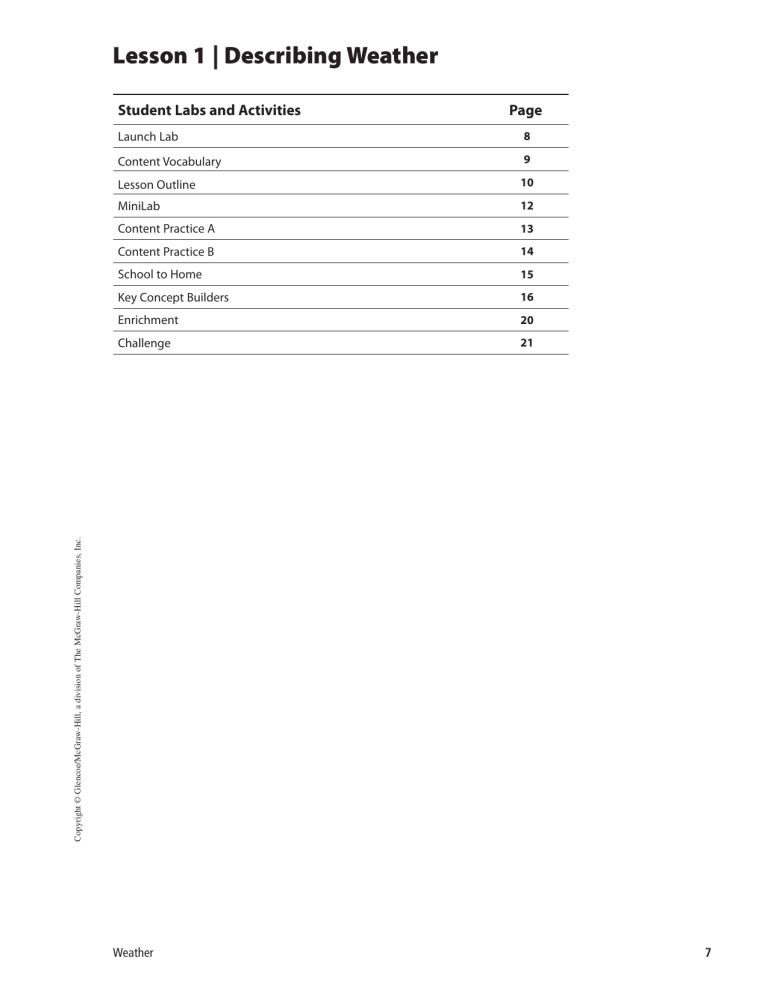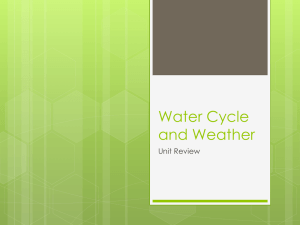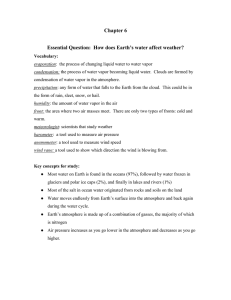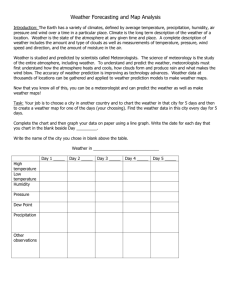Describing Weather: Student Labs & Activities
advertisement

Lesson 1 | Describing Weather Student Labs and Activities Page 8 Content Vocabulary 9 Lesson Outline 10 MiniLab 12 Content Practice A 13 Content Practice B 14 School to Home 15 Key Concept Builders 16 Enrichment 20 Challenge 21 Copyright © Glencoe/McGraw-Hill, a division of The McGraw-Hill Companies, Inc. Launch Lab Weather 7 Name Date Launch Lab Class LESSON 1: 15 minutes Can you make clouds in a bag? When water vapor in the atmosphere cools, it condenses. The resulting water droplets make up clouds. Procedure 1. Read and complete a lab safety form. 2. Half-fill a 500-mL beaker with ice and cold water. 4. Carefully lower the bag into the ice water. Record your observations in your Science Journal. 3. Pour 125 mL of warm water into a resealable sandwich bag and seal the bag. Think About This 1. What did you observe when the warm water in the bag was put into the beaker? 2. What explanation can you give for what happened? Key Concept What could you see in the natural world that results from the same process? 8 Weather Copyright © Glencoe/McGraw-Hill, a division of The McGraw-Hill Companies, Inc. 3. Name Date Class Content Vocabulary LESSON 1 Describing Weather Directions: Write the correct term in the boxes to the right of each definition. Then unscramble the letters in the shaded boxes to spell a ninth term. air pressure dew point humidity kinetic energy relative humidity variable water cycle weather precipitation 1. series of processes through which water moves around the globe 2. the amount of water vapor in the air compared to the maximum possible amount of water vapor the air can contain at that temperature 3. energy an object has because of its motion 4. atmospheric conditions at a certain place and time Copyright © Glencoe/McGraw-Hill, a division of The McGraw-Hill Companies, Inc. 5. a quantity that can be changed 6. a force exerted by a column of air 7. the amount of water vapor in the air 8. boundary at which water vapor becomes liquid water 9. When they are unscrambled, the letters from the shaded boxes spell , which includes rain, snow, and sleet. Weather 9 Name Date Class Lesson Outline LESSON 1 Describing Weather A. What is weather? 1. The atmospheric conditions, along with short-term changes, make up the of a certain place at a certain time. B. Weather Variables 1. Scientists who study and predict weather are 2. Air . is the measure of the average kinetic energy of molecules in the air. Molecules in warm air move molecules in cooler air. 3. than is the pressure that a column of air exerts on the air or surface below it. a. Air pressure decreases as altitude b. A(n) 4. . is an instrument used to measure air pressure. is caused by air moving from an area of high pressure to an area of low pressure. a. In a south wind, the wind is coming from the . . 5. The amount of water vapor in the air is a. When air is . , it holds the maximum amount of water vapor possible at that b. . is the amount of water vapor in the air compared to the maximum amount of water vapor the air can hold at that temperature. c. Relative humidity is reported as a(n) . 6. When air near the ground becomes saturated, the water vapor condenses into a liquid and forms . a. If the temperature is below 0°C, ice crystals, referred to as , form. b. The temperature at which air becomes fully saturated because the temperature decreases while the amount of moisture stays constant is the 10 . Weather Copyright © Glencoe/McGraw-Hill, a division of The McGraw-Hill Companies, Inc. b. The instrument used to measure wind speed is a(n) Name Date Class Lesson Outline continued 7. As warm air rises in the atmosphere, it . a. When the air cools enough that the is reached, small droplets of water form. b. are water droplets or ice crystals suspended in the atmosphere. c. is a cloud that forms near Earth’s surface. d. clouds are flat, white, and layered. e. clouds are fluffy and are present at 2,000 to 6,000 m altitude. f. clouds are wispy and are present above 6,000 m altitude. 8. is water, in liquid or solid form, that falls from the atmosphere. a. Precipitation that falls as liquid water is . b. Precipitation that is solid crystals of ice is . c. Precipitation that starts as snow and then melts and freezes again is Copyright © Glencoe/McGraw-Hill, a division of The McGraw-Hill Companies, Inc. called d. . is precipitation formed when ice pellets rise and fall within a cloud, adding new layers of ice during each cycle. 9. The is the series of natural processes in which water continually moves among oceans, land, and the atmosphere. a. Water enters the atmosphere as water vapor when liquid water on Earth’s surface b. As water vapor cools, it c. Clouds produce . , forming liquid water. , which is when liquid or frozen water falls to Earth’s surface. Weather 11 Name Date MiniLab Class LESSON 1: 20 minutes When will dew form? The relative humidity on a summer day is 80 percent. The temperature is 35°C. You want to find out if the dew point will be reached if the temperature drops to 25°C later that evening. Use the figure below to find the amount of water vapor needed for saturation at each temperature. Maximum Water Vapor in Air Water vapor in air (g/m3) 7 6 5 4 3 2 1 0 0 5 10 15 20 25 30 35 40 45 Temperature (°C) 1. Calculate the amount of water vapor in air that is 35°C at 80 percent relative humidity. (Hint: multiply the amount of water vapor air can contain at 35°C by the percent of relative humidity.) 2. At 25°C, air can hold 2.2 g/cm3 of water vapor. If your answer from step 1 is less than 2.2 g/cm3, the dew point is not reached and dew will not form. If the number is greater, dew will form. Analyze and Conclude Key Concept After the Sun rises in the morning, the air’s temperature increases. How does the relative humidity change after sunrise? What does the line represent? 12 Weather Copyright © Glencoe/McGraw-Hill, a division of The McGraw-Hill Companies, Inc. Procedure Name Date Class Content Practice A LESSON 1 Describing Weather Rain Cloud droplets Warm Raindrops Snow Ice Cloud crystals droplets Cold Snowflakes Sleet Ice crystals Hail Cloud droplets Cloud droplet Warm Raindrops Hail Cold Warm Ice crystal Warm Cold Directions: Use the diagram to answer each question. Question Rain Snow Sleet Hail Copyright © Glencoe/McGraw-Hill, a division of The McGraw-Hill Companies, Inc. What form is the water in when it is in the clouds— liquid or solid? What is the air temperature near the clouds—warm or cold? What is the air temperature near Earth’s surface—warm or cold? What is the form of precipitation that falls— liquid or solid? How are rain, snow, sleet, and hail part of the water cycle? What role does temperature play in the type of precipitation that develops? Weather 13 Name Date Content Practice B Class LESSON 1 Describing Weather Directions: Explain how each variable contributes to weather in the space provided. 1. Air pressure 2. Wind 3. Humidity 4. Relative humidity 5. Dew point 6. Clouds 7. Fog 8. Precipitation 9. Variables within the water cycle 10. Evaporation in the water cycle 11. Condensation in the water cycle 12. 14 Copyright © Glencoe/McGraw-Hill, a division of The McGraw-Hill Companies, Inc. Air temperature Weather Name Date School to Home Class LESSON 1 Describing Weather Directions: Use your textbook to answer each question. 1. Weather is the atmospheric conditions (and the short-term changes in those conditions) of a certain place at a certain time. What variables do meteorologists use to describe weather? 2. Air pressure is the pressure that a column of air exerts on the air or surface below it. Copyright © Glencoe/McGraw-Hill, a division of The McGraw-Hill Companies, Inc. What tool is used to measure air pressure? 3. When there is high humidity, there is a large amount of water vapor in the air. What is the difference between humidity and relative humidity? 4. Water vapor can condense in the air, creating clouds and fog. How are clouds and fog related to precipitation? Weather 15 Name Date Key Concept Builder Class LESSON 1 Describing Weather Key Concept What is weather? Directions: Put a check mark in the correct column to answer the question about weather. Then explain each answer. Does this fit the definition of weather? Yes No Why or why not? 1. It has been raining where you live for the past hour. 2. The average temperature in the summer is 42°C. 3. The temperature decreases 5°C in one hour and then decreases another 3°C in the next hour. 4. The day began sunny, but now there are plenty of clouds. 5. The region gets an average of 2.5 cm of rain each year. Copyright © Glencoe/McGraw-Hill, a division of The McGraw-Hill Companies, Inc. 6. You want to go on a bike ride, but you decide to go outside to check for dark clouds. 7. Heavy rainstorms are predicted for the next two hours, after which the sky should clear. 8. Ice formations are present across the region throughout the year. 9. Plants that require high amounts of moisture year-round grow in the area. 10. The clouds seem to be moving quickly, and the wind has started to blow harder. 11. The day began sunny, but now you wish you had an umbrella. 16 Weather Name Date Key Concept Builder Class LESSON 1 Describing Weather Key Concept What variables are used to describe weather? Directions: Use the clues and the terms listed below to complete the puzzle. air pressure air temperature barometric pressure humidity precipitation relative humidity dew point 1 2 3 4 Copyright © Glencoe/McGraw-Hill, a division of The McGraw-Hill Companies, Inc. 5 6 7 Clues Across 2. another term for air pressure 4. when water, in liquid or solid form, falls from the atmosphere 5. measure of the average kinetic energy Down 1. temperature at which air becomes fully saturated 3. pressure that a column of air exerts on the air or surface below it of molecules in the air 6. amount of water vapor in the air 7. amount of water vapor in the air relative to the maximum amount of water vapor the air can contain at that temperature Weather 17 Name Date Class Key Concept Builder LESSON 1 Describing Weather Key Concept What variables are used to describe weather? Directions: Answer each question or respond to each statement in the space provided. Variable Definition How is the variable measured? 1. 2. Air pressure 3. 4. Wind 5. 6. Humidity 7. 8. Relative humidity 9. 10. Dew point 11. 12. Clouds and fog 13. 14. Precipitation 15. 16. 18 Copyright © Glencoe/McGraw-Hill, a division of The McGraw-Hill Companies, Inc. Air temperature Weather Name Date Key Concept Builder Class LESSON 1 Describing Weather Key Concept How is weather related to the water cycle? Directions: On the line before each statement, write T if the statement is true and F if the statement is false. 1. Precipitation, condensation, and evaporation are important to the water cycle. 2. The water cycle is a natural process. 3. In the water cycle, water is constantly added to the atmosphere, where it builds up over time. 4. Most water enters the atmosphere through surface runoff. 5. Water vapor warms as it rises in the atmosphere. Copyright © Glencoe/McGraw-Hill, a division of The McGraw-Hill Companies, Inc. 6. Water vapor that evaporates eventually condenses. 7. Clouds form from liquid water and ice. 8. Evaporation occurs when water falls from clouds. 9. Water enters the atmosphere when it condenses. 10. Thermal energy causes water at the ocean’s surface to evaporate. Weather 19 Name Date Enrichment Class LESSON 1 The Power Plant for Weather The Sun’s energy powers the weather, from cloud formation to the entire water cycle. In fact, there would be no weather at all if we didn’t have the Sun. Earth receives less than a billionth of the energy that the Sun produces, but that is enough to run the water cycle, drive the weather, move ocean currents, maintain wind patterns, and enable photosynthesis. Electromagnetic Energy What causes weather? The Sun’s energy reaches Earth’s surface as parallel rays. If Earth were a flat disk that faced the Sun, all parts of the surface would receive an equal amount of energy. But Earth presents a curved surface to the incoming electromagnetic radiation from Applying Critical-Thinking Skills Directions: Respond to each statement. 1. Predict what Earth might be like without the Sun. 2. Explain in terms of angle of incidence why equatorial rain forests experience more vegetative growth and a wetter climate than other parts of Earth. 3. Summarize how typical weather conditions in the Amazon might differ from typical weather experienced in Anchorage, Alaska. 20 Weather Copyright © Glencoe/McGraw-Hill, a division of The McGraw-Hill Companies, Inc. The Sun drives most surface processes on Earth. The energy to do this work arrives on Earth’s surface in the form of electromagnetic energy. Electromagnetic energy is radiated by the Sun in waves. The range of electromagnetic energy Earth receives is the electromagnetic spectrum. This spectrum includes rapid, high-energy gamma rays; X-rays; ultraviolet rays; visible light; infrared; microwaves; and long, slow radio waves. Each of these types of waves is distinguished by wavelengths in a particular range. the Sun. Only one place on Earth—the equator—receives rays from the Sun straight on. All other areas receive rays at the angle of incidence. A location near the equator receives rays at a high, or more intense, angle of incidence, and a location near a pole receives rays at a low, or less intense, angle of incidence. The angle of incidence becomes increasingly lower with increasing latitude north or south. As Earth proceeds in its yearly orbit around the Sun, the angle of incidence varies with the seasons, except at the equator. Variations in the intensity of energy from the Sun received on Earth’s surface cause thermal energy to be unequally distributed in the atmosphere. This energy tends to move toward a more even distribution. The movement of energy results in more or less constant changes in the atmosphere, which cause the weather. Weather can be defined as the changes in the atmosphere at a given location for a short period of time. Earth’s rotation and orbit affect how much energy the parts of the surface receive from the Sun at any given time. Heating and cooling on a daily basis and on an annual basis drives changes in temperature, air pressure, winds, precipitation, humidity, cloud cover, and storms—all of which are weather variables. Name Date Class Challenge LESSON 1 Tracking Temperature Select a position outside your home where you can comfortably and easily check and record the outside temperature at least twice each day for a week. This will be your checkpoint. A convenient way to check the temperature is with a thermometer that hangs outside a window and can be read from the inside. Collect and Compare Data Choose two times during the day when you can record a low temperature and a high temperature. For example, record the temperature when you first get up in the morning, and again when you first come in from school in the afternoon. A sample chart is shown below. Choose a scale for your graph that is appropriate for the time of year. When you have a week’s high and low temperatures in your chart, create a graph to display your data. Plot the lows in one color, and plot the highs in another color. Temperature Data for Checkpoint: Monday Tuesday Wednesday Thursday Friday Saturday Sunday High Copyright © Glencoe/McGraw-Hill, a division of The McGraw-Hill Companies, Inc. Low Directions: Respond to each statement on the lines provided. 1. Identify the high and low temperatures for the week using the graph and your data. 2. Calculate the average high and average low temperatures for the week. Explain your method. 3. Explain how a meteorologist can use data like these to predict temperature changes from day to day and from year to year. Weather 21





